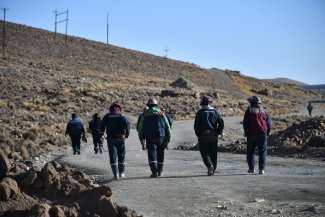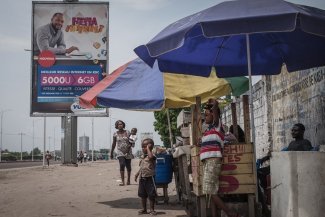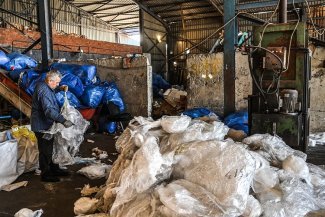The traditional profile of poverty has changed, it is becoming ever more diverse. Nowadays, you can be a university graduate and be poor. You can have a job (even two) and still not be able to pay the heating bills.
“No one dies of hunger in Spain.” That is what Joaquín Jiménez is told, time and again. And he, who heads the Banco de Alimentos (Food Bank) in Costa del Sol, can only agree. It’s true, in Spain, there is food.
The problem, as Joaquín well knows, is that sometimes people eat very little or very poorly, or simply eat the same thing every day. Almost half a million families in Spain cannot afford to eat properly, and when they do it is at the expense of everything else: paying the electricity bill, the mortgage, buying medication for asthma.
“We regularly attend to 45,000 people, which is almost twice as many as ten years ago,” says the head of the food bank. The European Commission may well insist that the crisis is over, but this warehouse in Malaga continues to pile up pallet after pallet loaded with jars of chickpeas, every day.
Poverty levels have fallen, in overall terms. That is what the World Bank’s latest report says: The percentage of the world’s people living in extreme poverty (on an income of less than US$1.90 a day), has gone from 36 to 10 per cent. There are now 736 million people living in extreme poverty, the lowest figure on record. But the picture is incomplete.
“That percentage only takes into account the economic component, income. It’s an inaccurate measure,” explains Raúl Flores, social researcher at Caritas Spain. As this expert argues, to paint a more realistic picture of the amount of people in need, “we would have to include other dimensions such as the quality of employment, social and political participation, education, housing or health”.
Because the traditional profile of poverty has changed, it is becoming ever more diverse. Nowadays, you can be a university graduate and be poor (for example, 13.8 per cent of Spain’s poor have a degree). You can have a job (even two) and still not be able to pay the heating bills.
The new poor and the traditional poor
During the worst years of the crisis, unemployment and austerity measures pushed thousands of ordinary families over the exclusion threshold. In Europe alone, the middle-class shrunk by 2.3 per cent. For the first time, poverty ceased to be associated with marginality. It could happen to anyone.
Today, 23.5 per cent of the EU population (118 million people) is still at risk. The figure has slowly been improving since 2012, but the balance is shaky. “They are people who may well be integrated but are highly vulnerable nonetheless. As long as everything is going well, there shouldn’t be any problem, but if another crisis strikes, many of them will fall into exclusion,” warns Flores.
In the midst of economic ‘recovery’, and despite the improvement in macroeconomic figures and the OECD’s announcement of four per cent growth in global GDP, many are still halfway between poverty and a precarious existence. And even work no longer necessarily provides a way out.
The deregulation of the labour market has given rise to legions of part-time workers, hourly workers and false self-employed workers, the ranks of the ‘working poor’. In 2008, they accounted for eight per cent of the workforce in the EU. The figure has now risen to 9.6 per cent. And as the International Labour Organization (ILO) warns, it could continue to rise.
“Work has become another factor of exclusion, which didn’t use to be the case. More and more hours are being worked for less money and this is creating other difficulties within the home, such as attending to children’s needs,” warns Begoña Pérez, professor of social work at the University of Navarra in Spain.
But it is not the middle-classes that have fared the worst. It is not the new poor but the poor of old who have seen a drastic fall in their living standards since the onset of the crisis, especially in countries such as Greece, Ireland and Spain.
In the case of Spain, the number of people living in severe poverty (with an income of less than €355 a month) have been rising every year, reaching as many as 3.2 million. “It’s the chronification of poverty, perpetuated generation after generation, and it is very difficult to eradicate,” says Juan Reyes, from the European Anti-Poverty Network (EAPN).
The one thing the new and the old poverty have in common is that both have an increasingly female face. A woman supporting a home is 25 per cent more likely to fall into exclusion than a man.
Poverty and guilt
For Susana Martín, a kitchen hand from Malaga, being poor means living by the day, having €10 one day and not knowing whether there will be enough for breakfast the next. “You make do with what you’ve got, but when you don’t even have enough for a carton of milk, it’s very hard.” She knows, because she struggled for years.
Now, thanks to the NGO Prodiversa, she has a job with which she is able to support her husband – an unemployed construction worker – and her three children. Although faced with many limitations, Susana manages to make ends meet, but confesses that she is still anxious.
There are some psychological states that don’t improve, even when the situation improves,” explains Ángela París, at psychologist at Prodiversa. “Poverty is a constant source of acute stress, and that causes physical and mental health problems, anxiety and a lack of self-confidence.”
Susana’s fear is more common than we imagine, as is the frustration, the sense of worthlessness or even guilt. Especially now, in the midst of the euphoria surrounding the recovery, it is society itself that continues to blame the poor for not succeeding.
As a study conducted in 2015 in the United Kingdom reveals, “Perceptions of those in poverty are extremely negative; they are stereotyped […]. The response to this stereotype is often contempt, harmful behaviours towards this group and belief that poverty results from personal failings.” And by making them solely responsible for their plight, we forget the structural causes, such as inequality. We overlook the fact that, at the same time as severe poverty is becoming chronic, the combined wealth of the world’s richest individuals has just surpassed US$70 trillion.
“More than poverty, the real problem is extreme wealth,” insists economist Luis Molina. “One per cent of the world’s population owns 50 per cent of the wealth. This means that they are absorbing a significant percentage of other people’s income. Trying to end poverty without looking at how those on top are doing makes no sense.”
Goal 2030
It seemed like a feasible goal when world leaders agreed, in 2015, to at least halve the proportion of men, women and children living in poverty and to eradicate extreme poverty by 2030. But with thirteen years to go, even the World Bank has dared to predict that, at this rate, we are not going to make it.
“It’s difficult. There is no clear commitment. Concrete policies are needed so that it doesn’t remain an empty promise,” says Daniel García, spokesperson for the NGO ATD Fourth World. There are proposals that have been on the table for years: how to facilitate access to housing or tackle precarious employment. As the ILO has underlined, “It will not be possible to reduce poverty in a lasting manner without decent work.”
And, as Reyes of the EAPN network insists, “We need a fair tax system, to fight against tax fraud.” This is the only way, he says, of bringing some balance to a recovery that, for the time being, is still very top heavy.
In any case, we have 13 years left to rethink what we mean by poverty, what it means to be poor, beyond the $1.90 a day. Santiago Álvarez, PhD in Economics and director of FUHEM Ecosocial, proposes that we stop talking about poverty and start talking about ‘quality of life”. It is a concept that goes beyond income levels and monetary wealth, measuring the right to live with dignity and not to merely eke out an existence. “This subjective construction of permanent crisis means that we do not aspire to live well, that we adapt to what is meted out to us. But what do people understand by a dignified life today? How many times have we asked ourselves this question?”










